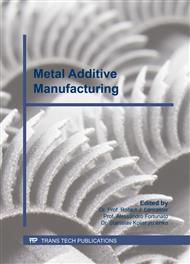[1]
J.A. Goldak, A. Chakravarti, New Finite Element Model for Welding Heat Sources, Metallurgical and Materials Transactions B 15(1984)299-305.
DOI: 10.1007/bf02667333
Google Scholar
[2]
J.P. Kruth, P. Mercelis, J. Van Vaerenbergh, L. Froyen, M. Rombouts, B. Lowers, Progress in additive manufacturing and rapid prototyping, CIRP Annals-Manufacturing Technology 47(2) (1998) 525-540.
DOI: 10.1016/s0007-8506(07)63240-5
Google Scholar
[3]
M. Larsson, U. Lindthe, O. Harrysson, Rapid Manufacturing with Electron Beam Melting (EBM) – A manufacturing revolution?, Solid Freeform Fabrication Symposium (2003) 433-438.
Google Scholar
[4]
A.F. Ribero, J. Norrish, Rapid prototyping process using metal directly, Solid Freeform Fabrication Proceedings (1996) 249-256.
Google Scholar
[5]
J. Xiong, G.J. Zhang, Forming appearance analysis in multi-layer single-pass GMAW-based additive manufacturing, International Journal of Advanced Manufacturing Technology (2015) 1767-1776.
DOI: 10.1007/s00170-015-7112-4
Google Scholar
[6]
J. Xiong, G.J. Zhang, Adaptive control of deposited height in GMAW-based layer additive manufacturing, Journal of Materials Processing Technology (2014) 962-968.
DOI: 10.1016/j.jmatprotec.2013.11.014
Google Scholar
[7]
G. Manongharan, B. Yelamanchi, R.Aman,Z. Mahbooba,Experimental Study of Disruption of Columnar Grains During Rapid Solidification in Additive Manufacturing, JOM (2016) 842-849.
DOI: 10.1007/s11837-015-1800-2
Google Scholar
[8]
M.J. Bermingham, D. Kent, H. Zhan, D.H. St John, M.S. Dargusch, Controlling the microstructure and properties of wire arc additive manufactured Ti–6Al–4V with trace boron additions, ActaMaterialia (2015) 289-303.
DOI: 10.1016/j.actamat.2015.03.035
Google Scholar
[9]
T. Abe, H. Sasahara, Dissimilar metal deposition with a stainless steel and nickel-based alloy using wire and arc-based additive manufacturing, Precision Engineering-Journal of the International Societies for Precision Engineering and Nanotechnology(2016).
DOI: 10.1016/j.precisioneng.2016.03.016
Google Scholar
[10]
J.D. Specer, P.M. Dickens, C.M. Wykes, Rapid prototyping of metal parts by three-dimensional welding, Proceedings of The Institution of Mechanical Engineers Part B-Journal of Engineering Manufacture (1998) 175-182.
DOI: 10.1243/0954405981515590
Google Scholar
[11]
O.F. Bondarenko, P.S. Safronov, I.V. Bondarenko, V.M. Sydorets,Direct energy and energy storage circuit topologies of DC power supplies for micro resistance welding, IEEE 34th International Scientific Conference on Electronics and Nanotechnology, ELNANO 2014 - Conference Proceedings, art. no. 6873431 (2014).
DOI: 10.1109/elnano.2014.6873431
Google Scholar
[12]
V. Sydorets, A. Lebedev, A. Dubko,Mathematical modeling of the current density distribution in a high-frequency electrosurgery, Proceedings - 2015 16th International Conference on Computational Problems of Electrical Engineering, CPEE 2015, art. no. 7333379 (2015).
DOI: 10.1109/cpee.2015.7333379
Google Scholar
[13]
D.P. lyaschenko, D.A. Chinakhov, Investigating the influence of the power supply type upon the weld joints properties and health characteristics of the manual arc welding, Materials Science Forum704-705(2012)608-611.
DOI: 10.4028/www.scientific.net/msf.704-705.608
Google Scholar



